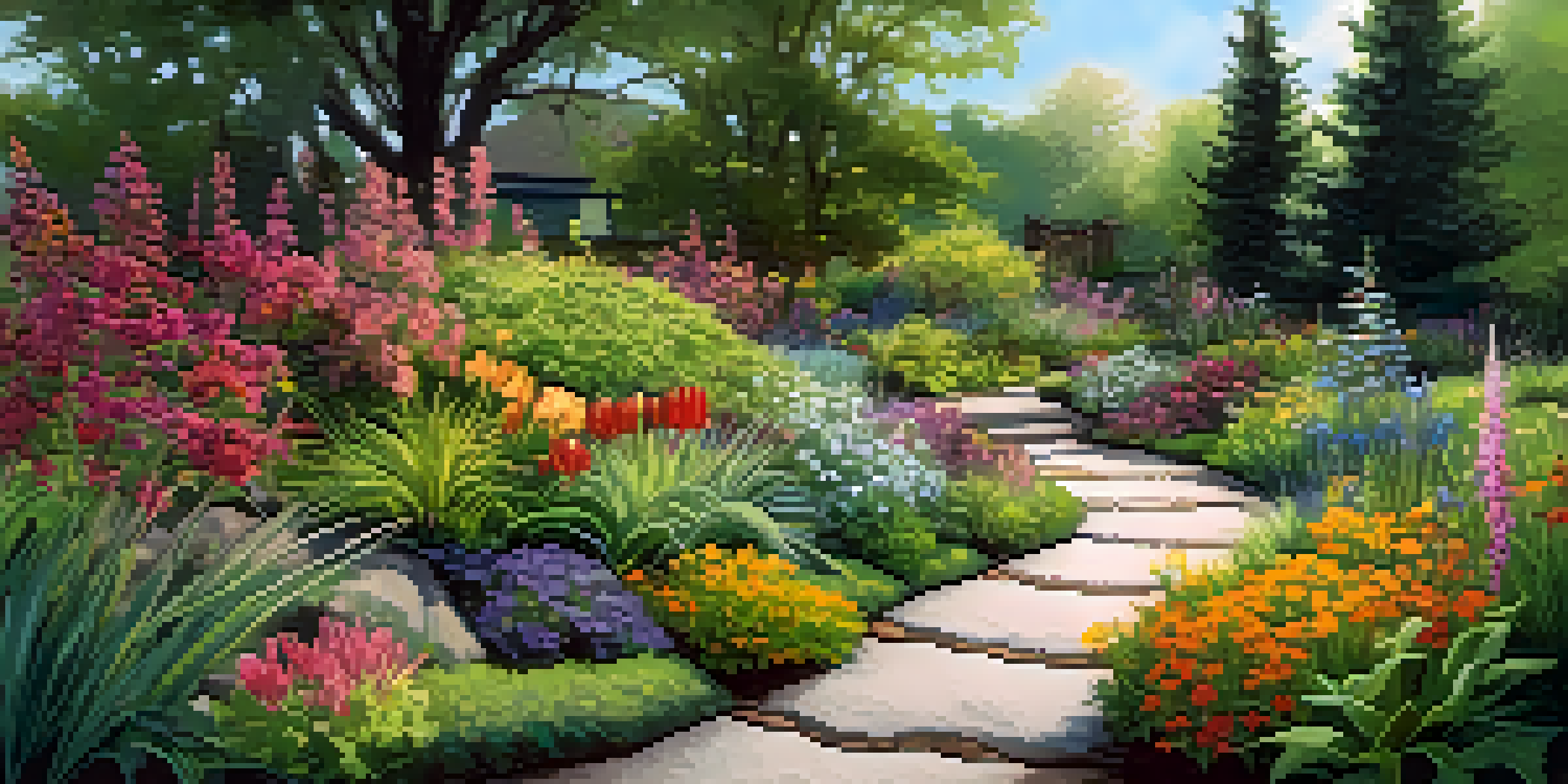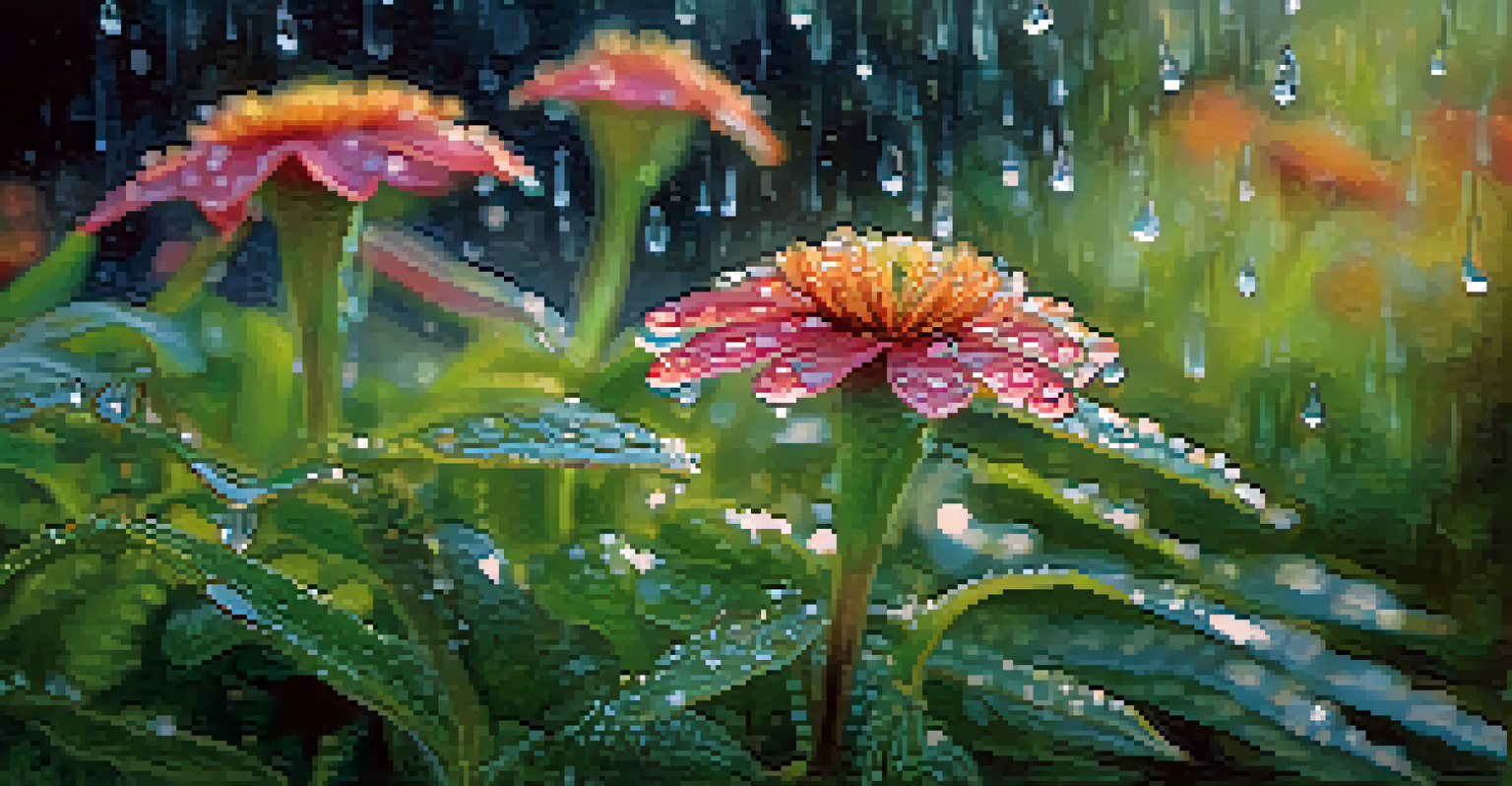Rain Gardens: Utilizing Native Plants for Stormwater Management

What is a Rain Garden and How Does It Work?
A rain garden is a shallow depression designed to capture and absorb stormwater runoff. By strategically placing native plants, these gardens mimic natural ecosystems, allowing water to soak into the ground rather than flood streets or enter storm drains. This simple yet effective design helps reduce pollution and erosion while recharging groundwater.
The creation of a rain garden is not just about managing stormwater; it's about creating a habitat that thrives with life and beauty.
When rain falls, instead of rushing off into storm sewers, the water collects in the rain garden. The native plants, with their deep roots, help filter the water and promote infiltration. This process not only manages excess water but also creates a habitat for local wildlife, turning a functional space into a vibrant ecosystem.
In essence, rain gardens serve as a beautiful solution to stormwater challenges. They not only provide a practical way to manage excess water but also enhance the landscape with colorful blooms and greenery. This dual purpose makes them an excellent choice for homeowners and communities alike.
Why Choose Native Plants for Your Rain Garden?
Native plants are specifically adapted to the local climate and soil, making them ideal for rain gardens. They require less maintenance, as they are naturally resilient to pests and diseases, and they thrive without the need for excessive watering or fertilization. This sustainability aspect not only saves time but also reduces environmental impact.

Additionally, native plants play a crucial role in supporting local wildlife, including pollinators like bees and butterflies. By incorporating these plants into your rain garden, you're creating a sanctuary for beneficial creatures, thus promoting biodiversity in your area. This connection to nature can also provide enjoyment and educational opportunities for families and communities.
Rain Gardens Manage Stormwater Effectively
Rain gardens capture and absorb stormwater runoff, reducing flooding and improving water quality.
Moreover, native plants are often more effective at managing stormwater. Their deep root systems can absorb more water and help prevent erosion, ensuring that your rain garden functions optimally. By choosing native species, you're not just beautifying your space; you're actively contributing to a healthier ecosystem.
Designing Your Rain Garden: Key Considerations
When designing a rain garden, the first step is to assess your yard's drainage patterns. Identify areas where water tends to accumulate and consider how a rain garden can fit into that landscape. It's essential to choose a location that is at least 10 feet away from buildings and has easy access to runoff sources, like downspouts or driveways.
Native plants are the backbone of a resilient landscape, providing essential support to local ecosystems while enhancing beauty.
Next, think about the size and shape of your rain garden. A larger garden will be able to hold more water, while a smaller one may still capture runoff effectively. Shapes can vary from circular to kidney-shaped, depending on your personal preference and yard layout. Remember, the goal is to create an aesthetically pleasing feature that blends well with your existing landscape.
Finally, consider the plants you want to include. Look for a mix of grasses, flowers, and shrubs that thrive in your region. Layering plants by height can create visual interest, while also ensuring effective water absorption. The key is to create a diverse ecosystem that will flourish in your rain garden.
Maintenance Tips for a Thriving Rain Garden
Maintaining a rain garden is relatively straightforward, especially when using native plants. Regularly check the garden for weeds, as they can compete with your native plants for nutrients and water. A simple hand-pulling or using mulch can help suppress weed growth without harming the ecosystem you've created.
During dry spells, it's important to monitor the moisture levels in your rain garden. Native plants typically require less watering, but newly planted species may need a little extra care until they establish their root systems. A thorough watering once a week can help them thrive during dry periods without becoming overly dependent on artificial irrigation.
Native Plants Enhance Biodiversity
Utilizing native plants in rain gardens supports local wildlife and promotes biodiversity in the ecosystem.
Seasonal clean-up is another crucial aspect of rain garden maintenance. In the fall, remove any dead plant material to prevent diseases and pests from overwintering. This practice not only keeps your garden looking tidy but also supports the health of your plants for the next growing season.
Benefits of Rain Gardens for the Environment
Rain gardens provide numerous environmental benefits, particularly in managing stormwater. By capturing runoff, they help reduce the amount of pollutants entering local waterways. This filtration process can significantly improve water quality in rivers, lakes, and streams, making a positive impact on the entire ecosystem.
Additionally, rain gardens play a vital role in reducing urban flooding. By allowing water to soak into the ground, they mitigate the risks associated with heavy rainfall. This is especially important in cities where impervious surfaces, like asphalt and concrete, can lead to overwhelming runoff and flooding during storms.
Furthermore, rain gardens contribute to biodiversity by providing habitats for various species. They serve as vital food sources for pollinators and attract birds, which in turn help control insect populations. By fostering a rich biodiversity, rain gardens enhance the overall health of our environment.
Rain Gardens: An Aesthetic Addition to Your Landscape
Beyond their functional benefits, rain gardens can add significant aesthetic appeal to your property. With a variety of native plants that bloom at different times throughout the year, you can create a dynamic and colorful landscape that changes with the seasons. This visual interest can enhance your home’s curb appeal and make the outdoor space more inviting.
Incorporating features like decorative stones, pathways, or benches can transform your rain garden into a peaceful retreat. Imagine stepping into a lush garden filled with vibrant flowers and the soothing sounds of water gently filtering through the soil. This serene environment can be a perfect spot for relaxation or social gatherings.
Aesthetic Appeal of Rain Gardens
Rain gardens not only serve a functional purpose but also add beauty and visual interest to landscapes.
Moreover, a well-designed rain garden can serve as an educational tool for neighbors and visitors. By showcasing how beauty and functionality can coexist, you inspire others to consider similar sustainable practices in their own yards. This ripple effect can contribute to a greater community commitment to environmental stewardship.
Getting Started: Resources and Support
If you're interested in creating a rain garden, numerous resources are available to guide you through the process. Local gardening centers often provide information on native plants suited for your area, along with design advice. Many communities also have extension services or environmental organizations that can assist with planning and implementation.
Additionally, online platforms and social media groups dedicated to gardening and sustainability can offer inspiration and support. These communities can be a great source for sharing experiences, troubleshooting challenges, and celebrating successes. Engaging with others who share your passion can make the journey more enjoyable.

Finally, consider attending workshops or webinars focused on rain gardens and sustainable landscaping. These educational opportunities can deepen your understanding of stormwater management and native plant benefits, empowering you to make informed decisions. Armed with knowledge and support, you’ll be ready to create a beautiful rain garden that nurtures both your yard and the environment.